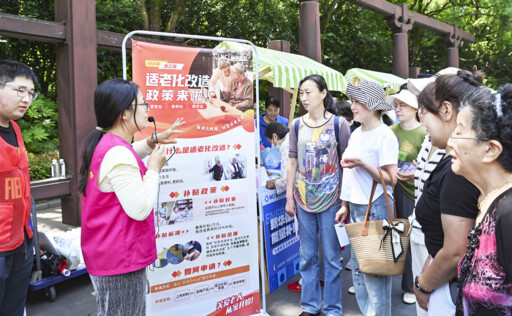


Self-directed adaptation helping older adults integrate into digital society

Local residents learning about the subsidy standards, eligibility, and application procedures for age-friendly home modifications in Wucheng District, Jinhua, Zhejiang Province Photo: IC PHOTO
In today’s digital and intelligent society, older adults often struggle to fully benefit from the conveniences of emerging technologies due to factors such as ingrained attitudes and cognitive limitations. To help them bridge the digital divide, the Chinese government has issued several policy documents, including the “Implementation Plan for Effectively Addressing the Challenges Facing Older Adults in Using Smart Technology” and the “Special Action Plan for Age-Friendly and Accessibility Upgrades of Internet Applications,” both of which have garnered widespread public attention. Yet dismantling the digital barriers facing older adults must be a collaborative process involving multiple stakeholders. Older persons themselves also need to strengthen their sense of agency by actively combining “age-friendly adaptation” with “self-directed adaptation.”
Rise of age-friendly upgrades
China is experiencing the dual transformations of an aging population and a rapidly digitalizing society. Digital technologies, as emerging social elements, are being embedded into the daily lives of older adults, creating a structural misalignment with the cognitive frameworks and habitual systems these individuals have built up over time. This mismatch heightens the risk of deepening the digital challenges older adults face both cognitively and practically. Such tensions not only hinder the building of an age-friendly society but may also weaken social integration mechanisms and erode governance effectiveness.
In response, China is advancing the development of an inclusive digital ecosystem. Internet service providers, websites, and mobile application developers are launching age-friendly and accessibility upgrades, improving the usability of digital infrastructure, products, and services for older adults in areas such as human-computer interaction, operating systems, push notifications, and service content. However, these efforts remain focused on technical refinements without fully addressing deeper issues of cognitive adaptation and cultural integration. From a governance perspective, only through multi-stakeholder collaborative governance—shifting from the “remedial logic” of “age-friendly adaptation” to the “symbiotic logic” of “self-directed adaptation”—can older persons truly integrate into the digital society and achieve intergenerational digital equity. “Self-directed adaptation” refers to older adults taking an active stance, mastering digital tools, and safeguarding themselves against digital risks.
Combining age-friendly and self-directed adaptations
The organic integration of “age-friendly adaptation” and “self-directed adaptation” constitutes a new issue within the framework of technology-society integration. At its core, it entails recognizing older adults as co-creators of the digital ecosystem and related rules, as well as joint participants in the governance of the digital society.
On one hand, social perceptions must change to eliminate stereotypes, prejudice, and exclusion directed toward older adults, while resisting narrow views that interpret intergenerational differences in digital life as intergenerational competition. Genuine social progress does not demand homogeneity among groups but instead upholds the principle of being “different yet equal.” Age-friendly adaptation entails acknowledging the physiological and psychological particularities of older adults and, through more inclusive design and supportive measures, ensuring that people of all ages are respected and enjoy equal opportunities to participate in the digital wave, thereby fostering an “age-inclusive civilization” within digital society.
On the other hand, older adults themselves must cultivate a stronger sense of active participation in digital society, overcoming tendencies toward self-marginalization and self-exclusion, enhancing their physical and psychological adaptability, and forming mutually beneficial relationships with other groups in digital life. Through multiple stakeholder interaction, the “otherness dilemma” caused by technological exclusion can be transformed into an “our issue” of collaborative governance, thereby advancing intergenerational justice in the digital public sphere. This constitutes the essence of self-directed adaptation.
Yan Ci is an assistant research fellow from the Institute of Population and Social Development at Henan Academy of Social Sciences.
Editor:Yu Hui
Copyright©2023 CSSN All Rights Reserved